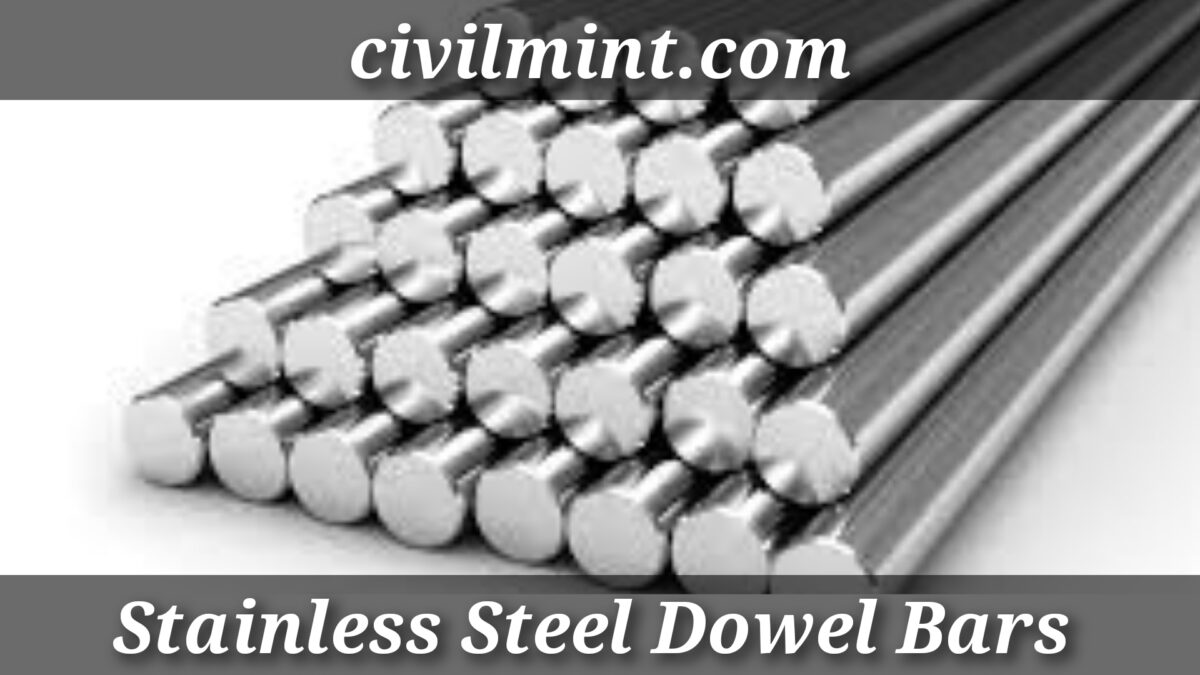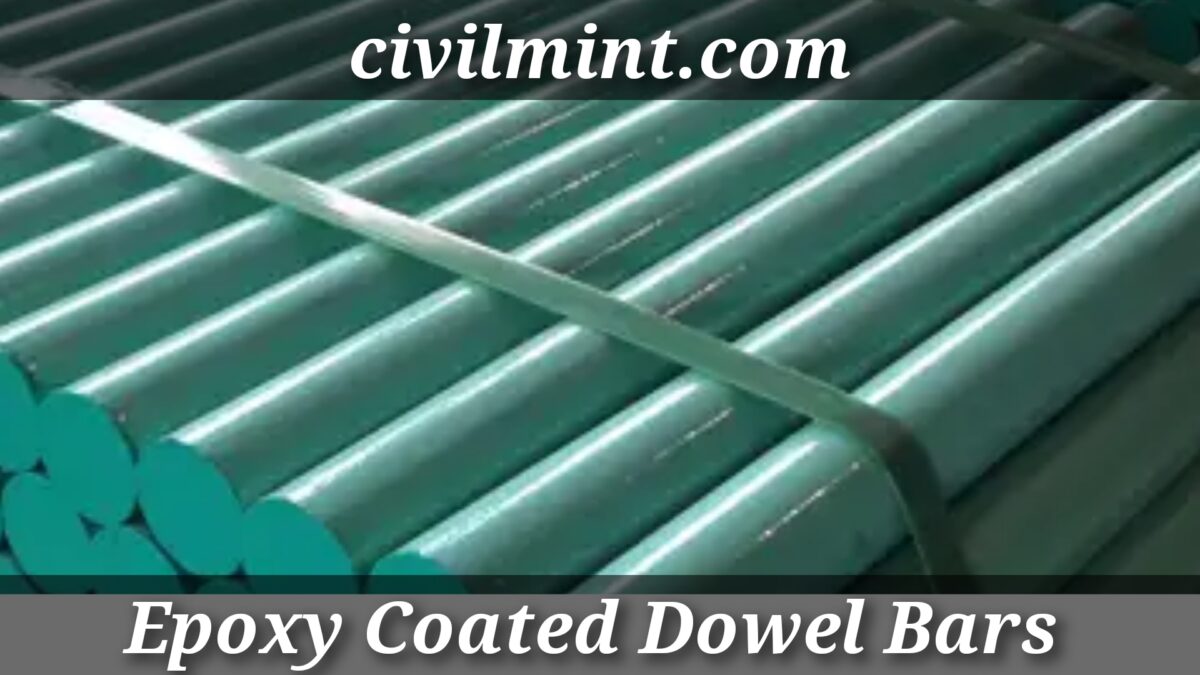Table of Contents
What Is Dowel Bar?
Dowel bar is a short round, smooth steel bar used to stipulate a mechanical connection between slab without restricting horizontal joint movement. These bars are chiefly used in jointed plain concrete pavement (JPCP) to carry the additional stress and load-induced due to the moving vehicle.

There are two types of dowel bars.
- Stainless steel dowel bar.
- Epoxy coated dowel bar.
Let us know about these two types of dowel bars
1. Stainless Steel Dowel Bars

Stainless steel dowel bars are made of high-quality stainless steel, which is highly resistant to corrosion and rust. They are commonly used in areas where moisture and chemicals are present, such as bridges and coastal roads. Stainless steel dowel bars do not require any additional coatings to prevent corrosion, making them a low maintenance option.
One of the main benefits of stainless steel dowel bars is their durability. They have a long lifespan and can withstand harsh weather conditions and heavy loads without deteriorating. They are also easy to install and do not require any special tools or equipment.
2. Epoxy Coated Dowel Bars

Epoxy coated dowel bars are made of carbon steel and are coated with an epoxy coating to prevent corrosion. The epoxy coating provides a barrier between the steel and the environment, protecting it from moisture, chemicals, and other corrosive elements. Epoxy coated dowel bars are commonly used in areas where the risk of corrosion is high, such as in areas with high humidity or where de-icing salts are used.
The epoxy coating on these dowel bars provides superior corrosion resistance, making them an ideal choice for harsh environments. They are also easy to install and can be cut to length on site, allowing for a custom fit in any application.
Purpose Of Dowel Bar:
Dowel bars are used for the following purposes.
- To transfer the load from one slab to its adjacent slab such that two successive slabs move together and reduce impact loading developed by the slabs by their independent movement.
- To decrease joint faulting and corner cracking.
- To better the performance of pavement joints.
The size of dowel bars relies on the thickness of the pavement. Normally, dowel bars are 18 inches (460mm) long, 1.25 to 1.5 inches (32 to 38 mm) in dia, and spaced 12 inches (305mm) apart. To prevent the bars from corrosion dowel bars are either stainless steel or epoxy coated.
Uses And Applications Of Dowel Bar
Here are some common applications of dowel bars in construction industry:
1. Concrete pavements:
Dowel bars are commonly used in concrete pavements to transfer loads from one slab to another. They help to reduce the stresses and strains that occur at the joints between concrete slabs, and can also help to prevent cracking and other forms of damage.
2. Airport runways:
Dowel bars are also used in airport runways to transfer loads from one section of the runway to another. This helps to ensure that the runway remains stable and safe for aircraft to land and take off.
3. Bridge decks:
Dowel bars are used in bridge decks to connect the adjacent precast concrete panels. They help to provide a smooth and stable surface for vehicles to drive on.
4. Industrial floors:
Dowel bars are commonly used in industrial floors, such as warehouse floors and factory floors, to provide load transfer between the concrete slabs. This helps to prevent cracking and other forms of damage that can occur due to heavy loads.
5. Parking lots:
Dowel bars are used in parking lots to provide load transfer between the concrete slabs. This helps to prevent the formation of cracks and other forms of damage that can occur due to heavy vehicle traffic.
Advantages Of Dowel Bars
- Increased load transfer capacity between adjacent concrete slabs.
- Helps to maintain the integrity of the joint.
- Reduces joint deflection.
- Improves the durability of the joint by reducing cracking.
- Increases the service life of the joint.
- Helps to reduce joint noise.
- Allows for efficient movement of vehicles.
- Increases the structural rigidity of the joint.
- Helps to prevent spalling at the joint.
- Allows for faster and more efficient construction.
- Reduces maintenance costs.
- Provides greater resistance to water penetration.
- Reduces the risk of joint failure due to weathering.
- Enhances the overall performance of the concrete pavement.
- Improves the load transfer efficiency and reduces slab movement.
Disadvantages Of Dowel Bars
- Increased construction cost due to the additional materials and labor required.
- Increases the complexity of the construction process.
- Can be difficult to install properly.
- Requires specialized equipment for installation.
- Can become dislodged or damaged during construction or maintenance activities.
- Can cause tripping hazards if not installed properly.
- Can cause a reduction in ride quality for vehicles.
- May not be necessary for all types of concrete pavements.
- Can cause premature failure if not installed properly or maintained adequately.
- Can interfere with surface water drainage in certain situations.
Faqs
Dowel bars range in diameter from 1/2 to 1 inch and can be up to 18 inches long. They are installed by drilling holes in the existing concrete and bonding them with epoxy or grout.
Tie bars hold reinforcement in place in a single concrete section, while dowel bars transfer loads and stresses between two sections.
Dowel bars are chosen based on the project type, expected loads and stresses, and the thickness and width of the concrete sections being joined.
Improper dowel bar installation can cause differential movement, leading to damage such as cracking. It can also create tripping hazards for pedestrians and damage to vehicles.
